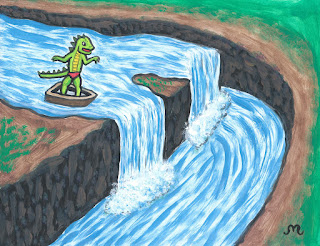Why Don’t Electric Trains Short Circuit in Rain?
Electric circuits have at least two poles: positive (+) and negative (-). In a normal closed circuit, the two poles are
kept at different voltages and electricity flows from the higher voltage pole to
the lower. A short circuit occurs when,
due to some fault, the voltage at both the poles become equal.
Electric trains cleverly avoid short circuit possibilities.
It uses the high voltage overhead power line as the positive pole and the train
track connected to the ground as the negative pole. The two are far apart that it is virtually
impossible that the two come in direct contact.
The train makes contact with the high voltage overhead wire
using a well-insulated device called the pantograph which creates a metal-on-metal
contact. Metals are a better conductor of electricity than water and therefore,
electricity flows along the metal (intended path) ignoring the water (the unintended
path)
Engineers have indeed tamed electricity. Now if only they
could find a way for trains to arrive on time.
References:



Comments
Post a Comment